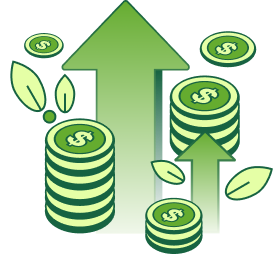Key takeaways
- Paycheck advance apps offer quick access to small amounts of money without credit checks or interest charges.
- Fees, tips, and instant transfer costs can add up if you rely on advances frequently.
- Building an emergency fund and budgeting can help you avoid short-term borrowing in the future.
Sometimes you need a small boost to make it to payday, like $50 to cover groceries or gas. Paycheck advance apps can be a convenient way to get quick access to that cash without turning to high-interest short-term loan due on your next paydays.
These apps typically offer small advances that you repay automatically when your paycheck hits. Ideally, you’re able to bridge short-term gaps without spiraling into debt.
We’ll explain , the safest ways to use them, and what to watch out for.
What is a paycheck advance app?
A paycheck advance app is a financial tool that lets you access money from your paycheck before your official payday. These apps fall into two main categories: and earned wage access (EWA) apps.
Temporary balance boost apps work independently of your employer and deposit a small loan into your account. You repay the advance, usually on your next payday, along with any optional tips or fees.
Earned wage access apps, on the other hand, only let you withdraw a portion of the wages you’ve already earned for hours worked. They often connect to your employer’s payroll system or require you to add an electronic timesheet so that they can track your hours. Your employer or the app usually deducts the amount you advance from your next paycheck.
Both options can help you cover small, urgent expenses without resorting to short-term loan due on your next paydays or high-interest credit cards. Before you choose an app, it’s essential to understand how they work.
How much does an advance cost?
The cost of a paycheck advance depends on the type of app and how quickly you need the money. Many paycheck advance apps market themselves as “no interest charges apply.” While they will not charge interest, they do come with fees.
Most often, they ask for optional tips, a flat fee, or a monthly subscription. Subscription-based apps typically charge a flat monthly fee, usually between $5 and $14. Subscribing gives you access to advances as well as additional features.
Instant transfer fees are another common fee. Standard transfers are usually free and can take anywhere from one to three business days. Instant transfers that send the money into your account in minutes can cost anywhere from $1 to $10 per advance.
While these costs are much lower than short-term loan due on your next payday fees or overdraft charges, they can still add up if you rely on advances frequently. To keep borrowing affordable, consider using free transfer options when possible and avoid over-tipping.
Looking for a small loan?
Can I get an advance without direct deposit?
Most paycheck advance apps require a linked bank account with regular direct deposits. The direct deposits help them to verify your income, determine how much you can safely borrow, and set repayment dates.
You may be able to find a $50 loan instant app with no direct deposit. Certain earned wage access apps work directly with your employer’s payroll system. They can automatically deduct repayment from your paycheck, even if you receive a paper check or pay card.
Do paycheck advances affect your credit?
Many modern paycheck advance apps do not report to credit bureaus or check your credit, meaning they don’t affect your score. Missing a payment will not hurt your credit, but it’s not without consequences.
If you do not repay the advance on time, the app will likely deny you another advance or lessen the amount you can borrow. A few paycheck advance apps may even charge a late payment fee.
A bigger concern is overdrafts. Repayment is typically automatic from your next paycheck or linked bank account. If you do not have the funds in your account to cover the advance, you may end up with an overdraft fee from your bank. While overdrafts won’t appear on your credit report, they can strain your finances.
How to get a $50 loan from an instant app
Getting a $50 advance is usually quick and straightforward. Here’s how most paycheck advance apps work:
1. Download and sign up: Choose an app and create an account. You’ll need to provide basic personal information and verify your identity.
2. Link your bank account: Connect your checking account to allow the app to view your bank transactions and direct deposit.
3. Verify your income: Some apps may require you to upload pay stubs or verify your employer. Others automatically analyze your direct deposits or want you to link an electronic timesheet.
4. Request your advance: Select the amount you need (for example, $50) and confirm the request. How much you can borrow depends on your income and past payment history.
5. Choose transfer speed: Standard transfers may take 1–3 days and are often free. Instant transfers usually cost a small fee, but you’ll receive funds in your account in minutes.
6. Repay automatically: When your paycheck arrives, the app will automatically withdraw the advance amount (plus any fees or tips). Some apps let you reschedule payments, while others have safety measures in place to avoid overdrafts.
Pros and cons of using a paycheck advance app
-
Quick access to cash
-
Usually cheaper than short-term loan due on your next paydays
-
No credit check required
-
Automatic repayment
-
Many apps offer budgeting tools or alerts
-
Fees or tips can add up with frequent use
-
Instant transfers often cost extra
-
May encourage a cycle of relying on advances
-
Risk of overdraft
Alternatives to paycheck advance apps
Paycheck advance apps can be helpful and have their place, but they aren’t your only option. One of the following alternatives may be more affordable, flexible, or better for your long-term financial health.
Emergency personal loans
Many lenders offer that can be used for emergencies. These loans typically have fixed interest rates, predictable monthly payments, and repayment terms ranging from a few months to a few years.
While approval may depend on your credit score, some lenders specialize in working with borrowers who have fair or poor credit. Consider checking with your credit union or local bank, as they tend to have more lenient credit requirements.
Credit card temporary balance boosts
If you have a credit card, you may be able to take out a temporary balance boost at an ATM or through your bank. You receive the cash instantly without an application.
The problem is that credit card temporary balance boosts are expensive. They come with high fees, usually 3% to 5% of the amount withdrawn, and interest accrues immediately. This option can work in a pinch, but it’s best to repay the balance quickly to minimize interest costs.
Buy now, pay later apps
Buy now, pay later (BNPL) services let you split a purchase into multiple interest-free payments. While they don’t give you cash, they can help you delay payment for essential purchases like groceries or household items. Just make sure you can keep up with the repayment schedule since missing payments can lead to late fees or even impact your credit.
401(k) loans
If you have a retirement plan through your employer, you might be able to borrow against your 401(k) savings. These loans have low interest rates and don’t require a credit check. Plus, you pay interest back into your retirement account.
While more affordable in the short term, borrowing from your retirement savings should be a last resort. It reduces your retirement savings, potentially impacting your long-term financial future. If you leave your job before the loan is repaid, you may have to pay it back quickly or face taxes and penalties.
Short-term installment loans
Short-term installment loans let you repay the borrowed amount over several weeks or months in fixed payments. The equal installments can make repayment more manageable. Check that the interest rate is reasonable before agreeing to the loan.
Seek help from a loved one
Borrowing from someone you trust can be one of the most affordable ways to get quick cash. Friends and family usually do not charge interest. Money can strain relationships, so consider putting the agreement in writing to avoid misunderstandings.
Use your emergency funds
If you have money set aside in an emergency fund, this is the perfect time to use it. Once your situation stabilizes, add the money back to your safety net.
Need cash but have a poor score?
How to avoid short-term borrowing
The best way to avoid relying on paycheck advances is to plan ahead and build a financial cushion. Start by creating a basic budget that tracks your income and expenses so you know where your money is going. Look for opportunities to cut back on nonessential spending and redirect that money into an emergency fund.
The rule of thumb is to have three to six months of living expenses saved. Three to six months can be a significant amount to save up all at once. Begin with a lower goal of $500 or $1,000, depending on your situation and location. Even saving $10 to $20 per paycheck can add up over time.
The idea is to have savings so as not to rely on short-term loans. With better budgeting and a safety net, you can avoid the fees and stress that come with borrowing to cover everyday expenses.
Frequently asked questions
1. Is it safe to get a $50 loan online?
It can be safe as long as you use a reputable paycheck advance app. Look for well-known apps with clear terms, no hidden fees, and strong security measures to protect your data.
2. Can I borrow $50 without a bank account?
You may be able to , but your options are limited. Some earned wage access apps work with employers and can send funds to a prepaid debit card or pay card. Alternatively, you could take out a credit card temporary balance boost or ask a trusted friend or family member for a short-term loan.
3. Can I use an instant loan app if I have poor credit?
Yes, most don’t rely on credit scores for approval. Instead, they look at your income and banking activity to decide your advance limit. This makes them accessible to people with poor or no credit.
4. How can I get money immediately?
Consider a paycheck advance app with instant transfer or a credit card temporary balance boost. Both options allow you to access money immediately without a lengthy application.
Bottom line
Paycheck advance apps can be helpful when you’re short on cash and need a small amount, like $50. They’re often faster, cheaper, and less risky than short-term loan due on your next paydays.
That said, use them carefully and avoid extra fees. Borrow only what you need and make sure you can cover the repayment when your paycheck arrives. Overusing advances can create a cycle of borrowing, making it harder to stay ahead financially.
Used wisely, paycheck advance apps can bridge the gap between paychecks without pushing you into debt.




